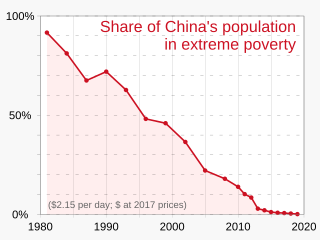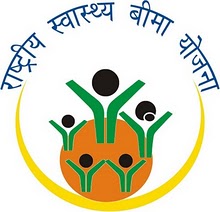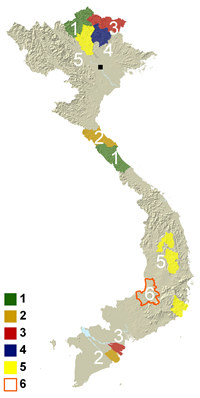Trade can be a key factor in economic development. The prudent use of trade can boost a country's development and create absolute gains for the trading partners involved. Trade has been touted as an important tool in the path to development by prominent economists. However trade may not be a panacea for development as important questions surrounding how free trade really is and the harm trade can cause domestic infant industries to come into play.

Poverty reduction, poverty relief, or poverty alleviation is a set of measures, both economic and humanitarian, that are intended to permanently lift people out of poverty.

In China today, poverty refers mainly to the rural poor. Decades of economic development has reduced urban extreme poverty. According to the World Bank, more than 850 million Chinese people have been lifted out of extreme poverty; China's poverty rate fell from 88 percent in 1981 to 0.7 percent in 2015, as measured by the percentage of people living on the equivalent of US$1.90 or less per day in 2011 purchasing price parity terms, which still stands in 2022. The Chinese definition of extreme poverty is more stringent than that of the World Bank: earning less than $2.30 a day at purchasing power parity (PPP), Since the start of far-reaching economic reforms in the late 1970s, growth has fuelled a substantial increase in per-capita income lifting people out of extreme poverty. China's per capita income has increased fivefold between 1990 and 2000, from $200 to $1,000. Between 2000 and 2010, per capita income also rose at the same rate, from $1,000 to $5,000, moving China into the ranks of middle-income countries. Between 1990 and 2005, China's progress accounted for more than three-quarters of global poverty reduction and was largely responsible for the world reaching the UN millennium development target of dividing extreme poverty in half. This can be attributed to a combination of a rapidly expanding labour market, driven by a protracted period of economic growth, and a series of government transfers such as an urban subsidy, and the introduction of a rural pension. The World Bank Group said that the percentage of the population living below the international poverty line of $1.9 fell to 0.7 percent in 2015, and poverty line of $3.2 fell to 7% in 2015. At the end of 2018, the number of people living below China's national poverty line of ¥2,300 (CNY) per year was 16.6 million, equal to 1.7% of the population at the time.

Water supply and sanitation in Rwanda is characterized by a clear government policy and significant donor support. In response to poor sustainability of rural water systems and poor service quality, in 2002 local government in the Northern Byumba Province contracted out service provision to the local private sector in a form of public–private partnership. Support for public-private partnerships became a government policy in 2004 and locally initiated public-private partnerships spread rapidly, covering 25% of rural water systems as of 2007.

Coffee production has been a major source of income for Vietnam since the early 20th century. First introduced by the French in 1857, the Vietnamese coffee industry developed through the plantation system, becoming a major economic force in the country. After an interruption during and immediately following the Vietnam War, production rose once again after Đổi mới economic reforms, making coffee second only to rice in value of agricultural products exported from Vietnam.

Below Poverty Line is a benchmark used by the government of India to indicate economic disadvantage and to identify individuals and households in need of government assistance and aid. It is determined using various parameters which vary from state to state and within states. The present criteria are based on a survey conducted in 2002. Going into a survey due for a decade, India's central government is undecided on criteria to identify families below poverty line.
Rural poverty refers to poverty in rural areas, including factors of rural society, rural economy, and political systems that give rise to the poverty found there. Rural areas, because of their spread-out populations, typically have less well maintained infrastructure and a harder time accessing markets, which tend to be concentrated in population centers.

Tuyên Quang is a province of Vietnam, located in the northeastern part of the country to the northwest of Hanoi, at the centre of Lô River valley, a tributary of the Red River. Its capital is Tuyên Quang. The province had a population of 784,811 in 2019, with a density of 130 persons per km2 over a total land area of 5,867.3 square kilometres (2,265.4 sq mi).
Community-driven development (CDD) is an initiative in the field of development that provides control of the development process, resources and decision making authority directly to groups in the community. The underlying assumption of CDD projects are that communities are the best judges of how their lives and livelihoods can be improved and, if provided with adequate resources and information, they can organize themselves to provide for their immediate needs. CDD projects work by providing poor communities with direct funding for development with the communities then deciding how to spend the money. Lastly, the community plans and builds the project and takes responsibility for monitoring its progress.

Rashtriya Swasthya Bima Yojana is a government-run health insurance programme for the Indian poor. The scheme aims to provide health insurance coverage to the unrecognised sector workers belonging to the BPL category and their family members shall be beneficiaries under this scheme. It provides for cashless insurance for hospitalisation in public as well as private hospitals. The scheme started enrolling on April 1, 2008 and has been implemented in 25 states of India. A total of 36 million families have been enrolled as of February 2014. Initially, RSBY was a project under the Ministry of Labour and Employment. Now it has been transferred to Ministry of Health and Family Welfare from April 1, 2015
Nigeria had one of the world's highest economic growth rates, averaging 7.4% according to the Nigeria economic report that was released in July 2019 by the World Bank. Following the oil price collapse in 2014–2016, combined with negative production shocks, the gross domestic product (GDP) growth rate dropped to 2.7% in 2015. In 2016 during its first recession in 25 years, the economy contracted by 1.6%. Nationally, 43 percent of Nigerians live below the poverty line, while another 25 percent are vulnerable. For a country with massive wealth and a huge population to support commerce, a well-developed economy, and plenty of natural resources such as oil, the level of poverty remains unacceptable. However, poverty may have been overestimated due to the lack of information on the extremely huge informal sector of the economy, estimated at around 60% more, of the current GDP figures. As of 2018, the population growth rate is higher than the economic growth rate, leading to a slow rise in poverty. According to a 2018 report by the World Bank, almost half the population is living below the international poverty line, and unemployment peaked at 23.1%.
Poverty in Sri Lanka is 4%. Sri Lanka's life expectancy and literacy rate are nearly on par with those of developed countries, and even top the rankings for the South Asia region. While all these indicate that Sri Lanka should be experiencing a high standard of living, until recently it has only ranked in the medium category of the Human Development Index (HDI). This is despite the fact that Sri Lanka has been experiencing moderate growth in its GDP averaging 5.5 per annum between 2006 and 2009. One of the reasons is due to its relatively low GDP per capital;. The Sri Lankan government has been successful in reducing poverty from 15.2% on 2006 to 8.9% in 2010, urban poverty was reduced from 6.7 to 5.3% while rural poverty was reduced from 15.7 to 9.5%, and the nation has made significant progress towards achieving Millennium Development Goals on eradicating extreme poverty and hunger.
The island country of Madagascar remains plagued by political and economic instability, poverty, and food insecurity. While the country engaged in an ambitious transformation program designed to improve social, economic, and governance indicators between 2002 and 2008, a 2009 political crisis has thrown these improvements off-course. This political strife, in combination with the global financial downturn, led to a 4 percent decline in economic growth in 2009.

In 2021, official government statistics reported that the Philippines had a poverty rate of 18.1%,, significantly lower than the 49.2 percent recorded in 1985 through years of government poverty reduction efforts. From 2018 to 2021, an estimated 2.3 million Filipinos fell into poverty amid the economic recession caused by the COVID-19 pandemic.

Until the 1920s, most of the Vietnamese population lived under the poverty line. This was due to a number of reasons, which was a result from years as a French colony, the Japanese occupation of Vietnam, the Vietnam-American War, and further conflicts within Mainland Southeast Asia. Continuous conflicts from 1887 to 1991, more than 100 years of instability had left Vietnam a war-torn country that was prone severe floods from typhoons, rising sea levels, as well as the so-called "flood season" from seasonal monsoons, as well as the effects of climate change.

Vision 2021 was the political manifesto of the Bangladesh Awami League party before winning the National Elections of 2008. It stands as a political vision of Bangladesh for the year 2021, the golden jubilee of the nation. The policy has been criticized as a policy emblematic of technological optimism in the context of Bangladesh and the state repression of media, low internet penetration, inadequate electricity generation. The Vision 2021 is an articulation of where this nation needs to be in 2021 – the year which marks the 50th anniversary of Bangladesh's independence.
Tanzania has a current population of 55.57 million people. Current statistics form the World Bank show that in 2011, 49.1% of Tanzanians lived below US$1.90 per day. This figure is an improvement over 2007's report indicating a poverty rate of 55.1%. Tanzania has seen annual GDP gains of 7% since 2010 and this economic growth is attributed to this positive trends for poverty alleviation in Tanzania. The 2019 World Bank report showed that in the last 10 years, poverty has reduced by 8 percent, from 34.4% in 2007 to 26.4% in 2018.
Universal basic income in India refers to the debate and practical experiments with universal basic income (UBI) in India. The greatest impetus has come from the 40-page chapter on UBI that the Economic Survey of India published in January 2017. It outlined the three themes of a proposed UBI programme:
Deen Dayal Antyodaya Yojana or DAY is one of the Government of India scheme for helping the poor by providing skill training. It replaces Aajeevik. The Government of India has provisioned ₹500 crore (US$63 million) for the scheme. The objective of the scheme is to train 0.5 million people in urban areas per annum from 2016. In rural areas the objective is to train 1 million people by 2017. Further, in urban areas, services like SHG promotion, training centres, vendors markets, and permanent shelters for homeless. The aim of the scheme is skill development of both rural and urban India as per requisite international standards.

Vietnam joined the World Bank Group (WBG) on 21 September 1956. Before the mid-1980s, Vietnam was one of the world's least developed countries. A series of economic and political reforms launched in 1986, known as Đổi Mới, caused Vietnam to experience rapid economic growth and development, becoming a lower middle-income country. The World Bank (WB) has maintained a development partnership with Vietnam since 1993. As of 25 March 2019, it has committed a total of US$24 billion in loans, credits, and grants to Vietnam through 165 operations and projects, 44 of which are active as of 2019 and comprise US$9 billion. With an estimated extreme poverty rate below 3% and a GDP growth rate of 7.1% in 2018, Vietnam's economy continues to show fundamental strength and is supported by robust domestic demand and export-oriented manufacturing.











